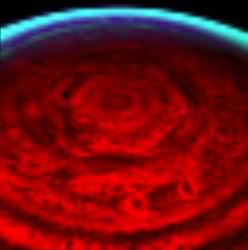 New Cassini infrared images of Saturn have revealed one of its strangest features – a bizarre six-sided cloud structure circling the entire north pole. This structure was hinted at when the Voyager spacecraft first visited the planet more than 20 years ago, but the new images from Cassini really show the structure in detail.
New Cassini infrared images of Saturn have revealed one of its strangest features – a bizarre six-sided cloud structure circling the entire north pole. This structure was hinted at when the Voyager spacecraft first visited the planet more than 20 years ago, but the new images from Cassini really show the structure in detail.
Continue reading “Hexagonal Structure at Saturn’s North Pole”
Enceladus Might Mask the Length of Saturn’s Day
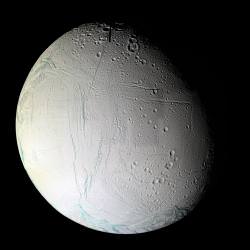 You’d think it would be an easy question to answer: how long is Saturn’s day? But it’s been a puzzle for astronomers for many years. On other gas planets, astronomers just measure the rotation of their magnetic fields. The problem is that the Ringed Planet’s field rotates slower than the rest of the planet, and it changes.
You’d think it would be an easy question to answer: how long is Saturn’s day? But it’s been a puzzle for astronomers for many years. On other gas planets, astronomers just measure the rotation of their magnetic fields. The problem is that the Ringed Planet’s field rotates slower than the rest of the planet, and it changes.
Continue reading “Enceladus Might Mask the Length of Saturn’s Day”
Seas Discovered on Titan
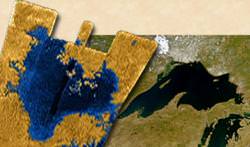 Planetary scientists had reported lakes around Titan’s southern poles, but now it looks like the northern hemisphere has liquid on the surface as well. Of course, we’re not talking about water, that would be frozen solid. These are seas filled with liquid methane or ethane.
Planetary scientists had reported lakes around Titan’s southern poles, but now it looks like the northern hemisphere has liquid on the surface as well. Of course, we’re not talking about water, that would be frozen solid. These are seas filled with liquid methane or ethane.
Continue reading “Seas Discovered on Titan”
Radioactive Core Might Explain Geysers on Enceladus
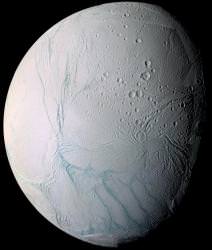 Since Cassini arrived at Saturn, it has made many impressive discoveries. One of the most intriguing is the discovery that Saturn’s icy moon Enceladus has geysers spewing water ice into space. Some planetary scientists theorize that there are pockets of liquid water near the surface of Enceladus that could harbour life. But where is the heat coming from to fuel these geysers?
Since Cassini arrived at Saturn, it has made many impressive discoveries. One of the most intriguing is the discovery that Saturn’s icy moon Enceladus has geysers spewing water ice into space. Some planetary scientists theorize that there are pockets of liquid water near the surface of Enceladus that could harbour life. But where is the heat coming from to fuel these geysers?
Continue reading “Radioactive Core Might Explain Geysers on Enceladus”
Large Lake Surrounds an Island on Titan
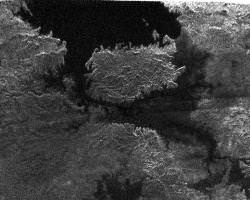 NASA’s Cassini spacecraft has been turning up new images of features that look like lakes on the surface of Saturn’s moon Titan. This latest image shows a large lake that appears to be surrounding an island.
NASA’s Cassini spacecraft has been turning up new images of features that look like lakes on the surface of Saturn’s moon Titan. This latest image shows a large lake that appears to be surrounding an island.
Continue reading “Large Lake Surrounds an Island on Titan”
Unique New Perspectives of Saturn
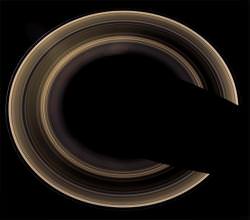 Now flying in a polar orbit around Saturn, NASA’s Cassini spacecraft is now sending back completely unique images of Saturn, seen from overhead. The photograph that I’ve attached to this story shows Saturn seen from almost directly overhead. The planet itself has been removed, so just the rings are visible. But there are other images taken over the last two months.
Now flying in a polar orbit around Saturn, NASA’s Cassini spacecraft is now sending back completely unique images of Saturn, seen from overhead. The photograph that I’ve attached to this story shows Saturn seen from almost directly overhead. The planet itself has been removed, so just the rings are visible. But there are other images taken over the last two months.
Continue reading “Unique New Perspectives of Saturn”
New Crater Discovered on Titan
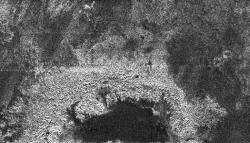 NASA’s Cassini spacecraft captured this image of a semi-circular feature on Saturn’s moon Titan. Planetary geologists think that it might be a relatively recent impact crater on Titan. This would be surprising, since all the data gathered on Titan shows that its surface is relatively young, constantly weathered and resurfaced by weather conditions – only three impact craters have been found on Titan so far.
NASA’s Cassini spacecraft captured this image of a semi-circular feature on Saturn’s moon Titan. Planetary geologists think that it might be a relatively recent impact crater on Titan. This would be surprising, since all the data gathered on Titan shows that its surface is relatively young, constantly weathered and resurfaced by weather conditions – only three impact craters have been found on Titan so far.
Continue reading “New Crater Discovered on Titan”
What Else Could Be Spewing Out of Enceladus?
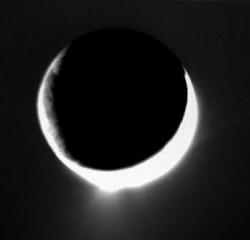 One of the biggest space news stories of 2006 was the Cassini’s discovery that water ice was spraying out the bottom of Saturn’s moon Enceladus. It could be that the tiny moon is under such gravitational flexing from Saturn that it refuses to freeze solid. Researchers then went on to propose that this spray of ice is actually regenerating Saturn’s E ring.
One of the biggest space news stories of 2006 was the Cassini’s discovery that water ice was spraying out the bottom of Saturn’s moon Enceladus. It could be that the tiny moon is under such gravitational flexing from Saturn that it refuses to freeze solid. Researchers then went on to propose that this spray of ice is actually regenerating Saturn’s E ring.
Continue reading “What Else Could Be Spewing Out of Enceladus?”
Daphnis Walks the Knife Edge
Saturn’s tiny moon Daphnis makes waves as it orbits the Ringed Planet. Even though it’s only 7 km (4.3 miles) across, the moon’s gravity draws material along the edges of the Keeler gap, creating the serrated knife edge you see in this picture. Cassini took this photo on Ocrober 27, 2006 when it was approximately 325,000 kilometers (202,000 miles) from Daphnis.
Continue reading “Daphnis Walks the Knife Edge”
Pan Clearing a Gap in Saturn’s Rings
If you want to understand what causes the gaps in Saturn’s rings, just look at this picture. The bright object in the middle of Saturn’s Encke gap is one of its moons: Pan. The tiny moon is only 26 km (16 miles) across, but its minor gravity can clear out the ring particles. Cassini took this image on October 27, 2006 when it was 385,000 km (239,000 miles) from Pan.
Continue reading “Pan Clearing a Gap in Saturn’s Rings”
